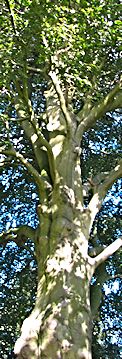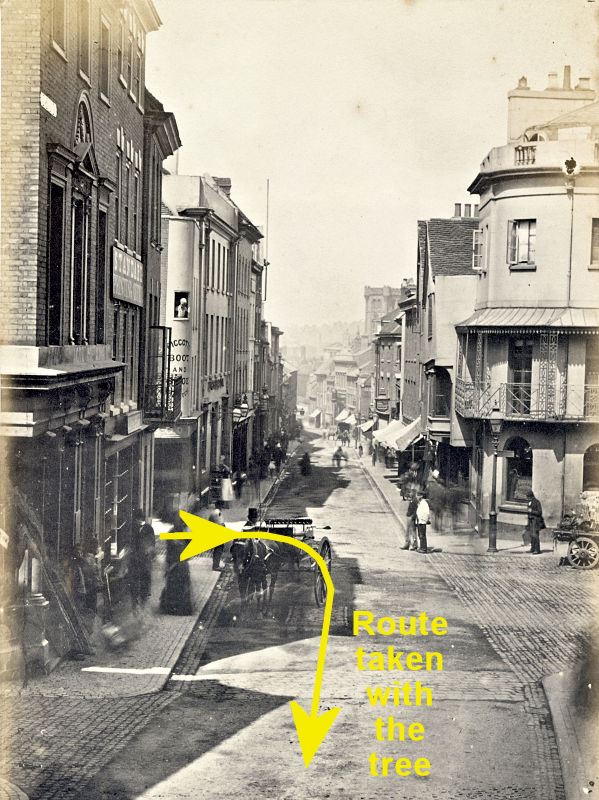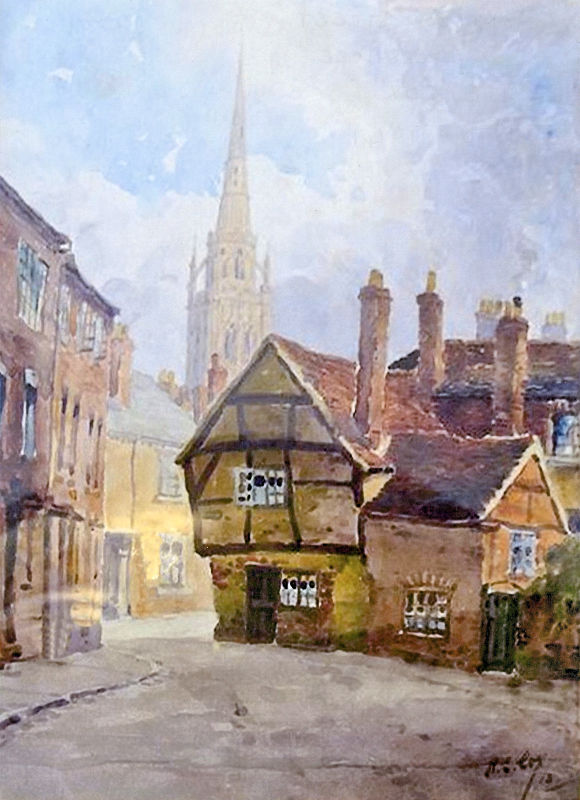The Beech on Wheels
Why Coventry shouldn't cut down its history
In October 2012 a member of the Historic Coventry Forum named 'Foxcote' discovered an intriguing newspaper article from a 1850 Coventry Herald (transcript on the right), describing how, on the 15th of October that year, an already mature beech tree was moved from its position next to Warwick Road (where the Quadrant now stands) to the London Road Cemetery, near to the Dissenter's Burial Chapel.
Within a few days another member, 'Robthu', picked up on this, as he has a special affinity with this cemetery. He responded; "I spend a lot of time on the trees in the cemetery and this could explain why one purple beech is different to all of the others, it is in the right place to be the one in the article."
And so began a new 21st century journey of discovery for this magnificent tree, to learn all the facts about its origin and its first great journey back in the middle of the 19th century.
Victorian antiquarian, Benjamin Poole, in his 1852 History of Coventry, adds the following to the Herald's article:
 Its immense roots were embedded in the earth without delay, and ever since, whatever scientific and skillful management could do to prevent its vitality from declining, has been done for that purpose. The experiment has been watched with some interest, and up to this period (the winter of 1851) - the opinions of horticulturists are divided on the question, whether so large a tree will long survive transplantation ; - whether it can be again so firmly routed as to preserve its beauty in a flourishing condition for many years longer. It stands on a flat piece of ground a short distance from the Dissenters' burial chapel, and will easily be distinguished when in leaf, by its dark and majestic foliage.
Benjamin Poole, 1851
With the benefit of a century and a half of hindsight, we now happily say that the optimistic horticulturists were the correct ones!
Its immense roots were embedded in the earth without delay, and ever since, whatever scientific and skillful management could do to prevent its vitality from declining, has been done for that purpose. The experiment has been watched with some interest, and up to this period (the winter of 1851) - the opinions of horticulturists are divided on the question, whether so large a tree will long survive transplantation ; - whether it can be again so firmly routed as to preserve its beauty in a flourishing condition for many years longer. It stands on a flat piece of ground a short distance from the Dissenters' burial chapel, and will easily be distinguished when in leaf, by its dark and majestic foliage.
Benjamin Poole, 1851
With the benefit of a century and a half of hindsight, we now happily say that the optimistic horticulturists were the correct ones!
 Its immense roots were embedded in the earth without delay, and ever since, whatever scientific and skillful management could do to prevent its vitality from declining, has been done for that purpose. The experiment has been watched with some interest, and up to this period (the winter of 1851) - the opinions of horticulturists are divided on the question, whether so large a tree will long survive transplantation ; - whether it can be again so firmly routed as to preserve its beauty in a flourishing condition for many years longer. It stands on a flat piece of ground a short distance from the Dissenters' burial chapel, and will easily be distinguished when in leaf, by its dark and majestic foliage.
Benjamin Poole, 1851
Its immense roots were embedded in the earth without delay, and ever since, whatever scientific and skillful management could do to prevent its vitality from declining, has been done for that purpose. The experiment has been watched with some interest, and up to this period (the winter of 1851) - the opinions of horticulturists are divided on the question, whether so large a tree will long survive transplantation ; - whether it can be again so firmly routed as to preserve its beauty in a flourishing condition for many years longer. It stands on a flat piece of ground a short distance from the Dissenters' burial chapel, and will easily be distinguished when in leaf, by its dark and majestic foliage.
Benjamin Poole, 1851 NOVEL TRANSPLANTATION. - A singular scene was exhibited through a line of the principal streets in this city, on Tuesday afternoon last, in the removal of a full-grown tree, from the late nursery-ground of Mr. Ogden, at Warwick Row, to the Cemetery on the London Road. This tree, a purple beech, was planted by the late Alderman Weare when he occupied the nursery, and could not be far short of a century old. It was of splendid growth, and its beautiful proportions rendered it a perfect picture, and the admiration of all who looked upon it. The removal has been a work of considerable time, difficulty, and expense. A number of workmen were employed several weeks in excavating the roots. When this was done, the placing of it upon a carriage in a fit manner for transit was a most perplexing operation ; especially after the breaking down of one carriage in the experiment. Then came the somewhat hazardous undertaking of conveying it in an upright position along the thoroughfares - Hertford Street, High Street, Earl Street, and Much Park Street, to the Cemetery. The making of this route occupied several hours, amidst many hundreds, if not thousands, of spectators. There were various stoppages ; and not a few loppings off of branches became necessary, in order to prevent excessive damage to the fronts of houses, thus mutilating and depriving the tree to some extent of its exquisite symmetry ; and notwithstanding all the sacrifices made, and precautions taken, some mischief ensued, though not to any very great amount, in the breaking of windows and other defacings. On arriving at the Cemetery it was taken up Green Lane, where a part of the wall was taken down to admit its entry to that part of the ground destined to receive it. The result of this undertaking will now be watched with some interest in ascertaining whether so large and mature a tree can be firmly rooted, and still preserved in the flourishing beauty which has won for it so much admiration, and that high valuation, which led to the determination to transfer it from one spot to the other.
Coventry Herald
NOVEL TRANSPLANTATION. - A singular scene was exhibited through a line of the principal streets in this city, on Tuesday afternoon last, in the removal of a full-grown tree, from the late nursery-ground of Mr. Ogden, at Warwick Row, to the Cemetery on the London Road. This tree, a purple beech, was planted by the late Alderman Weare when he occupied the nursery, and could not be far short of a century old. It was of splendid growth, and its beautiful proportions rendered it a perfect picture, and the admiration of all who looked upon it. The removal has been a work of considerable time, difficulty, and expense. A number of workmen were employed several weeks in excavating the roots. When this was done, the placing of it upon a carriage in a fit manner for transit was a most perplexing operation ; especially after the breaking down of one carriage in the experiment. Then came the somewhat hazardous undertaking of conveying it in an upright position along the thoroughfares - Hertford Street, High Street, Earl Street, and Much Park Street, to the Cemetery. The making of this route occupied several hours, amidst many hundreds, if not thousands, of spectators. There were various stoppages ; and not a few loppings off of branches became necessary, in order to prevent excessive damage to the fronts of houses, thus mutilating and depriving the tree to some extent of its exquisite symmetry ; and notwithstanding all the sacrifices made, and precautions taken, some mischief ensued, though not to any very great amount, in the breaking of windows and other defacings. On arriving at the Cemetery it was taken up Green Lane, where a part of the wall was taken down to admit its entry to that part of the ground destined to receive it. The result of this undertaking will now be watched with some interest in ascertaining whether so large and mature a tree can be firmly rooted, and still preserved in the flourishing beauty which has won for it so much admiration, and that high valuation, which led to the determination to transfer it from one spot to the other.
Coventry HeraldBeginnings
An 1851 map showing the nursery, the probable location of the tree and, if you hover or click on the map, an overlay showing where the Quadrant now stands.
This 1847 view of Coventry's three spires had barely a decade remaining before the area in front of the spires would become dominated by The Quadrant. Move your cursor over the image to reveal a photo taken by Steven Orland showing the same scene in 2014.
Then and now
Moving your cursor over the image above will bring you into the 21st century, so we can compare the two scenes from a similar viewpoint a century and a half apart. The map below, although from 1870, has been used to show the probable route taken by the tree. The last part of the route across the northern edge of the cemetery must remain supposition until we learn otherwise, but studies of contemporary maps indicate that other paths were not likely to have been able to take such a large tree. Please also note that the "Green Lane" mentioned in the Coventry Herald article as running down the west side of the cemetery, was renamed in 1933 to Quarryfield Lane. A 19th century tree moving group, similar to the one that would've been responsible for moving the Coventry tree.... no 100 ton mechanical lifting devices in those days!
A 19th century tree moving group, similar to the one that would've been responsible for moving the Coventry tree.... no 100 ton mechanical lifting devices in those days! This is showing the repositioning of a huge Beech tree in the grounds of Shelley's Hotel in Lewes.
This is showing the repositioning of a huge Beech tree in the grounds of Shelley's Hotel in Lewes.The beech route
As explained in the original Coventry Herald article above, the tree was taken to the cemetery via Hertford Street, High Street, Earl Street and Much Park Street. Although the London Road was not specifically mentioned, the earlier Board of Health map shows the whole area in great detail, and once down Much Park Street the London Road would have been by far the only feasible route wide enough to accommodate such a grand cavalcade.
 On the final leg of the journey, part of the cemetery's boundary wall required removal to enable access from Green Lane as the tree was brought to its resting place near the Dissenters' Burial Chapel. This 2012 photograph on the left shows the section of fence that can be removed, and the short piece of wall, which would have been rebuilt soon after the operation.
The street opposite nowadays is Gillquart Way, but back in 1850 that area was open fields boxed in by Mile Lane, the cemetery and the railway. Between the wars, however, the Armstrong Siddeley owned Burlington Carriage Works, and later Rolls-Royce, occupied much of the land now covered by this modern housing estate.
On the final leg of the journey, part of the cemetery's boundary wall required removal to enable access from Green Lane as the tree was brought to its resting place near the Dissenters' Burial Chapel. This 2012 photograph on the left shows the section of fence that can be removed, and the short piece of wall, which would have been rebuilt soon after the operation.
The street opposite nowadays is Gillquart Way, but back in 1850 that area was open fields boxed in by Mile Lane, the cemetery and the railway. Between the wars, however, the Armstrong Siddeley owned Burlington Carriage Works, and later Rolls-Royce, occupied much of the land now covered by this modern housing estate. The gap through which the Purple Beech was transported.
The gap through which the Purple Beech was transported. The Purple Beech tree at the London Road Cemetery in 2012
The Purple Beech tree at the London Road Cemetery in 2012For more images please check out this Gallery









